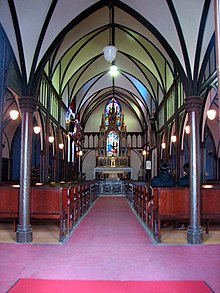Basilica of the Twenty-Six Holy Martyrs of Japan (Nagasaki)
| Basilica of the Twenty-Six Holy Martyrs of Japan | |
|---|---|
日本二十六聖殉教者聖堂 | |
 | |
| Location | Nagasaki |
| Country | Japan |
| Denomination | Catholic |
| Tradition | Latin Rite |
| History | |
| Dedication | 26 Martyrs of Japan |
| Architecture | |
| Style | Gothic Revival |
| Completed | 1864 |
| Administration | |
| Archdiocese | Archdiocese of Nagasaki |

The Basilica of the Twenty-Six Holy Martyrs of Japan[1] (日本二十六聖殉教者聖堂) also Oura Cathedral [Church] (大浦天主堂, Ōura Tenshudō) is a Catholic minor basilica[1] and co-cathedral[1] in Nagasaki, Japan, built soon after the end of the Japanese government's Seclusion Policy in 1853. It is also known as the Church of the 26 Japanese Martyrs. For many years it was the only Western-style building declared a national treasure, and is said to be the oldest Christian church in Japan.
History
In 1863, two French priests from the Société des Missions Étrangères, Fathers Louis Furet and Bernard Petitjean, landed in Nagasaki with the intention of building a church honoring the Twenty-Six Martyrs of Japan, eight European priests, one Mexican priest and seventeen Japanese Christians who were crucified in 1597 by order of Toyotomi Hideyoshi. The church was finished in 1864. Constructed by the master carpenter of the Glover Residence, Koyama Hidenoshin, it was originally a small wooden church with three aisles and three octagonal towers.[2] The present structure is a much larger Gothic basilica that dates from around 1879. This version was built of white stuccoed brick with five aisles, vaulted ceilings, and one octagonal tower. The design most likely came from a Belgian plan used by Catholic missionaries in an earlier church built in Osaka.[3] The stained glass windows were imported from France.
On March 17, 1865, shortly after the completion of the original cathedral, Father Petitjean saw a group of people standing in front of the cathedral. They indicated to the priest that they wanted him to open the doors. As the priest knelt at the altar, an old woman from the group approached him and said "The heart (faith) of all of us is the same as yours. Where is the statue of Holy Mary?"[4] Petitjean discovered that these people were from the nearby village of Urakami and were Kakure Kirishitans, descendants of early Japanese Christians who went into hiding after the Shimabara Rebellion in the 1630s. A white marble statue of the Virgin Mary was imported from France and erected in the church to commemorate this event. The bronze relief in the courtyard below the church shows the memorable scene of the discovery. Before long, tens of thousands of underground Christians came out of hiding in the Nagasaki area. News of this reached Pope Pius IX, who declared this "the miracle of the Orient."
Ōura Cathedral was designated as a National Treasure in 1933. During World War II, the cathedral was damaged by the atomic bomb on August 9, 1945.[5] Artifacts from the damage are in the Nagasaki Atomic Bomb Museum.
The National Treasure designation was affirmed on March 31, 1953 under the 1951 Law for the Protection of Cultural Properties. It was the first Western-style building in Japan to be given this honor and had been the only one until 2009 when the neo-Baroque Akasaka Palace was designated a National Treasure.

The church was granted status as a minor basilica by the Holy See on April 26, 2016 [6]
On June 30, 2018 Ōura Cathedral, along with 11 other sites linked to Catholic persecution in Japan, was added to the UNESCO World Heritage List.[7][8]
See also
References
- ^ a b c "Basilica of the Twenty-Six Holy Martyrs of Japan (Oura Church), 長崎 (Nagasaki), 長崎県 (Nagasaki), Japan". www.gcatholic.org. Retrieved 2017-01-31.
- ^ Dallas Finn, Meiji Revisited: The Sites of Victorian Japan, (New York: Weatherhill, 1995), 12-13.
- ^ Finn 13.
- ^ Francisque Marnas, La Religion de Jesus Ressuscitée au Japon dans la seconde moitie de XIX siècle., 2 vols. (Paris: Delhomme et Briguet, 1897), 487-490. direct link
- ^ Oura Cathedral, by kyushuandtokyo.org
- ^ "Japan gets its first minor Basilica".
- ^ "Hidden Christian Sites in the Nagasaki Region".
- ^ "UNESCO adds Japanese sites linked to persecution of Christians to World Heritage list". July 2018. Archived from the original on 2018-07-01. Retrieved 2018-06-30.
External links
![]() Media related to Oura Church at Wikimedia Commons
Media related to Oura Church at Wikimedia Commons
- Nagasaki City Tourism Guide - Ōura Cathedral Archived 2013-05-10 at the Wayback Machine